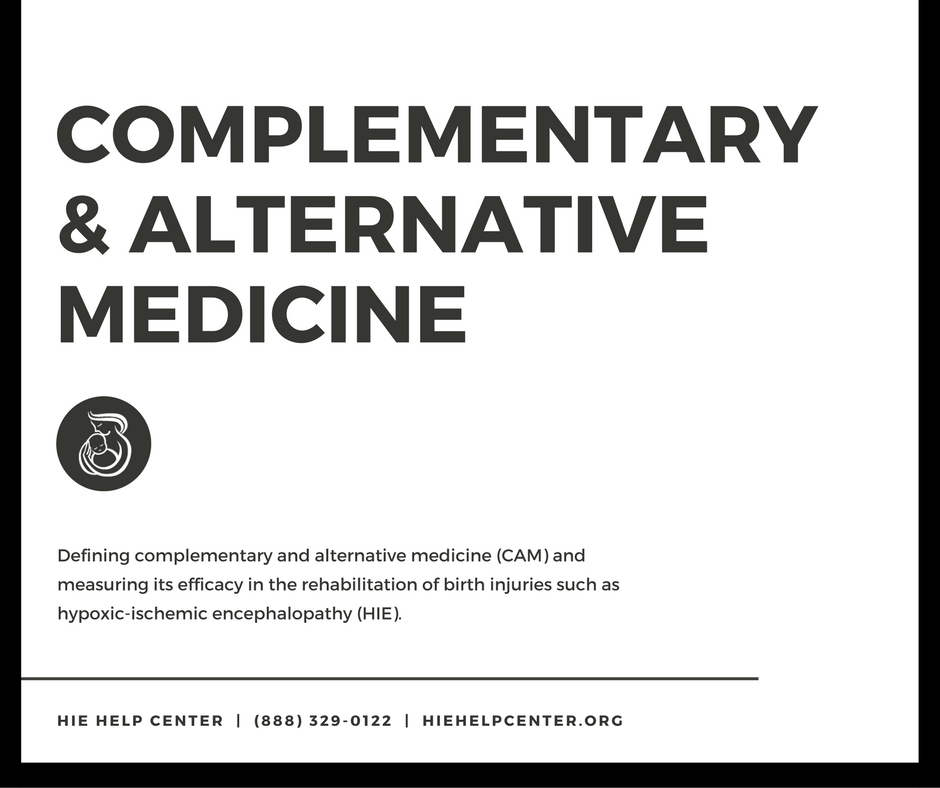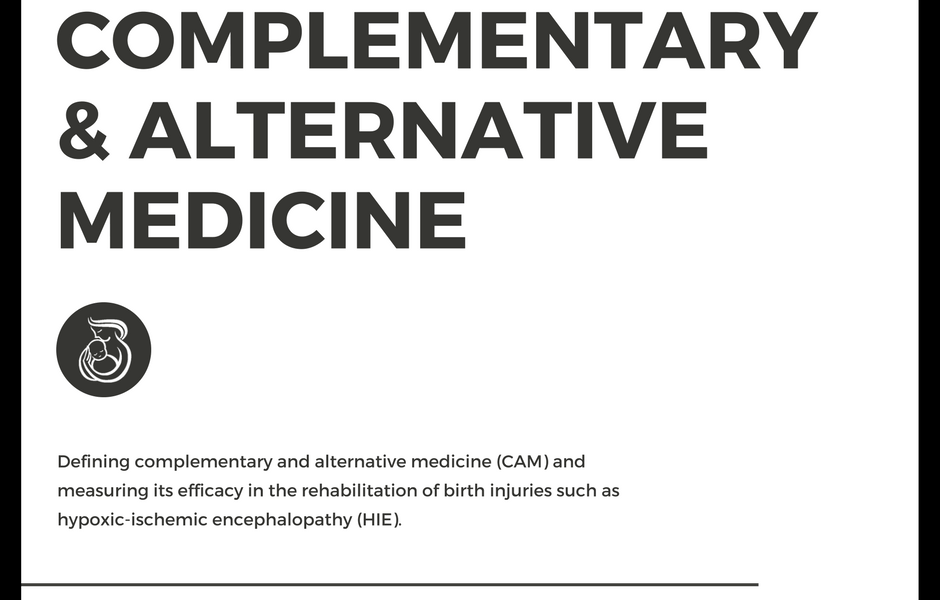One hot topic in the treatment of children with hypoxic-ischemic encephalopathy (HIE) and other developmental disabilities is the use of complementary, alternative, or integrative medicine. Because the boundaries between medicine, alternative practice, and what is considered ‘mainstream’ treatment can be confusing, we’re providing a short primer on what exactly these different terms mean.
What is conventional or mainstream medicine?
Conventional medicine is what most practitioners with MD or DO degrees practice – the focus is often on treating existing ailments within the context of very specific scientific frameworks. Treatments fall under the purview of ‘evidence-based medicine (EBM)’, which tests different treatments to confirm that they are effective and safe. These treatments are tested in a hierarchy, with only rigorously-tested procedures or treatments passing into the realm of ‘clinical practice guidelines’ (1).
What is complementary and alternative medicine (CAM)?
According to the National Center for Complementary and Integrative Health (NCCIH), it has been reported that roughly 12% of children and over 30% of adults use health care approaches that are not typically part of conventional medicine. People often use the term Complementary and Alternative Medicine, or CAM, to describe this, but each word means something different, and other words have been used to describe these treatments as well (2).
Complementary: Non-mainstream medical care that is used together with mainstream medical care.
Alternative: Non-mainstream medical care that is used in place of mainstream medical care.
Integrative: Healthcare that coordinates non-mainstream and mainstream elements to provide a holistic treatment.
What can complementary and alternative medicine look like?
Complementary and integrative health practices can be divided into two general categories: natural products and mind/body practices (2).
Natural products
Natural products are products that are taken as dietary supplements or for health issues that are not regulated. These include products like:
- Vitamins and minerals
- Herbs
- Probiotics
Mind and body practices
Mind and body practices include techniques or procedures, including things like:
- Yoga
- Meditation
- Chiropractic care
- Acupuncture
- Hypnotherapy
Additionally, some complementary health treatments do not fit into either of these categories. These can include practices like:
- Homeopathy
- Traditional Chinese medicine
- Naturopathy and more
Some medical practitioners can be cautious regarding recommending CAM therapies, because many (if not most) have not undergone rigorous testing to confirm their safety.
Is CAM effective?
People have been using complementary, alternative, and integrative health practices for thousands of years, passing practices down from generation to generation (3). It is not possible to say that CAM therapies as a whole are effective, however, many have simply never been tested for clinical efficacy. Controlled trials are expensive, which can make CAM efficacy testing difficult. Conventional medicine research is often supported by private firms, so clinical trials are feasible for them. CAM generally doesn’t have the same kind of backing, so clinical trials are more difficult to carry out (4, 5).
It is important to note, however, that without rigorous tests, it is very difficult to know what the possible risks and benefits of a CAM therapy could be. While some clinical trials for CAMs demonstrate some benefits, the benefits do not pass the standards for controlled clinical trials. Because of this, parents should exercise caution and talk to a medical professional to help make informed decisions if they are considering CAM therapies.
How complementary and alternative therapies are tested for efficacy
The National Center for Complementary and Integrative Health (NCCIH) is the federal government’s agency intended for scientific research on complementary and integrative health practices (2). They work hard to determine the usefulness and safety of these different therapies and methods.
To demonstrate that CAM therapies are effective, there are three ‘tiers’ of support for their use (1, 6). The most rigorous is a demonstration of clinical outcomes through controlled clinical trials. Less rigorous is a demonstration of established physiological mechanisms of action (i.e., demonstrating that a treatment has an effect on some specific process that occurs in the body). The least persuasive is historical use; this is generally considered anecdotal and unreliable evidence.
Before trying a complementary or alternative therapy
Before trying an alternative therapy, remember that doctors are trained and licensed. CAM practitioners often don’t have to be, and many are not. Many health professionals recommend asking a healthcare provider such as a primary care physician for a referral if you are interested in CAM services, gathering information about the practitioner, and asking about the pros and cons of treatment – just like you would with any other medical care provider (4).
About the HIE Help Center
The HIE Help Center is run by ABC Law Centers, a medical malpractice firm exclusively handling cases involving HIE. Our lawyers have been advocating for families affected by birth injuries since 1997.
If you suspect your child’s HIE may have been caused by medical negligence, contact us to learn more about pursuing a case. We provide free legal consultations, during which we will inform you of your legal options and answer any questions you may have. Moreover, clients pay nothing throughout the entire legal process until we obtain a favorable settlement.
You are also welcome to reach out to us with inquiries that are not related to malpractice. We cannot provide individualized medical advice, but we’re happy to track down informational resources for you.
Related resources:
- National Center for Complementary and Integrative Health: Complementary, Alternative, or Integrative Health: What’s In a Name?
- MedlinePlus: Learning about CAM? Start Here!
- Complementary and Alternative Healthcare: Is it Evidence-based?
Sources
- Burns, P. B., Rohrich, R. J., & Chung, K. C. (2011). The levels of evidence and their role in evidence-based medicine. Plastic and reconstructive surgery, 128(1), 305–310. doi:10.1097/PRS.0b013e318219c171
- (2019, April 2). Complementary, Alternative, or Integrative Health: What’s In a Name? Retrieved from https://nccih.nih.gov/health/integrative-health
- NIH Fact Sheets – Complementary and Alternative Medicine. Retrieved from (Archived)
- (2018, June 7). Integrative medicine: Alternative becomes mainstream. Retrieved from https://www.virginislandsdailynews.com/integrative-medicine-alternative-becomes-mainstream/article_b7cb1f58-bba6-5368-aadf-a549b4131bc5.html
- Tabish S. A. (2008). Complementary and Alternative Healthcare: Is it Evidence-based?. International journal of health sciences, 2(1), V–IX.
- Yamey G. (2000). Can complementary medicine be evidence-based?. The Western journal of medicine, 173(1), 4–5. doi:10.1136/ewjm.173.1.4



Leave a Reply
You must be logged in to post a comment.